One of my favorite parts of writing this WeRunFar column is its monthly kick-in-the-butt motivation. I spend hours immersed in the lives of runners of all kinds: Hardrock devotees, Western States veterans, and many others. I relish in the descriptions of the mountains of Colorado, the cheers of the crowds at races around the world, and the passions pouring out of the runner on the other side of the phone.
I always end the call with, “Hey, have a great day and maybe I’ll see you on the trails sometime!” I say this with the hope that one day I will make my way to North Carolina, Colorado, Hawaii, or any of the places from which our interviewees hail, and that I might be able to match a friendly face to the voice on the phone.
But, after talking with Tim Hewitt about his many Alaskan adventures, I think I might rather stay at home in the Midwest.
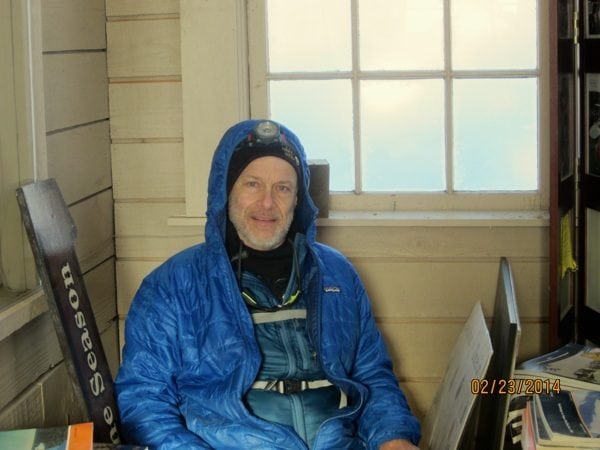
Tim Hewitt sitting in the Knik Museum in Knik, Alaska before the start of the 2014 Iditarod Trail Invitational. All photos courtesy of Tim and Loreen Hewitt.
Hewitt, 61, finished his ninth Iditarod Trail Invitational—the 1,000-mile foot-race version of the multi-sport, multi-distance, multi-route event which takes place on the famed Iditarod Trail in Alaska—late on a Friday night of this past March, setting a new course record for the event’s Northern Route in 19 days, 9 hours, and 38 minutes.
Tim himself has called the race “impossible,” but he seemingly lives for the Alaskan event and was, arguably, born to be in the snow. He admits that he also loves to turn on his car’s seat heater when driving to work during the winters of his Pennsylvania home.
He said his doctor recently told him his body naturally stays below what’s normal for an average human. He said, laughing, “I have a low body temp, but I do get cold. I don’t know, maybe that helps me.” This natural physiologic phenomenon may be a small factor in his impressive history with the Iditarod Trail Invitational, but it is more likely his dedication, focus, and practice that have led him so many times to the 1,000-mile marker in Nome, Alaska, where the Iditarod Trail ends.
“I knew as long as I maintained the pace and did the work I would get the record,” he reflected on the March race. “I always felt the Northern Route [of the Iditarod Trail—the Invitational travels the north route on even years and the south route on odd years] could be done in under 20 days. Nobody had done that though and they thought it was impossible.” It was an accomplishment to check off the list, Tim added. “It was a goal I set a long time ago. It may not be meaningful to many people, but I was happy and it was complete satisfaction.”
Over the last 16 years, Tim has completed both the Southern Route and the Northern Route multiple times and holds both records. He has done it unsupported. His wife, Loreen, has also done it multiple times.
So, what next?
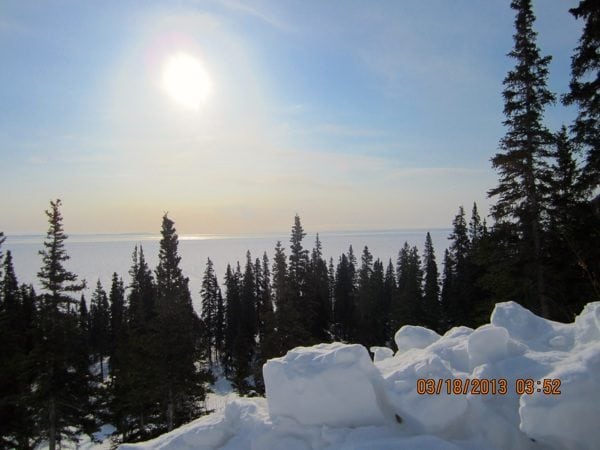
Tim’s view near the village, Elim, along the course.
Tim was not a runner in high school, but instead was a wrestler turned gymnast who attended Northern Michigan University on a gymnastics scholarship. He was born in Pennsylvania and continues to live in the area of Greensburg. After graduating from NMU in 1976 with a business degree, he decided to thaw out in Florida for law school.
In 1978, he graduated and returned to Pennsylvania to begin working as an employment lawyer and start a family with Loreen. The couple has four daughters, two who live in San Francisco and two who live within a few hours of the family home.
It was a few years later when he started getting serious about running, since he despised running during high school and only took it up to stay fit while in law school. In 1985, he ran his first Pittsburgh Marathon. The May 2016 edition of the Pittsburgh Marathon was his 27th go at the race, making him one of the few runners to have run every single edition put on. (Some years, the race was not held.)
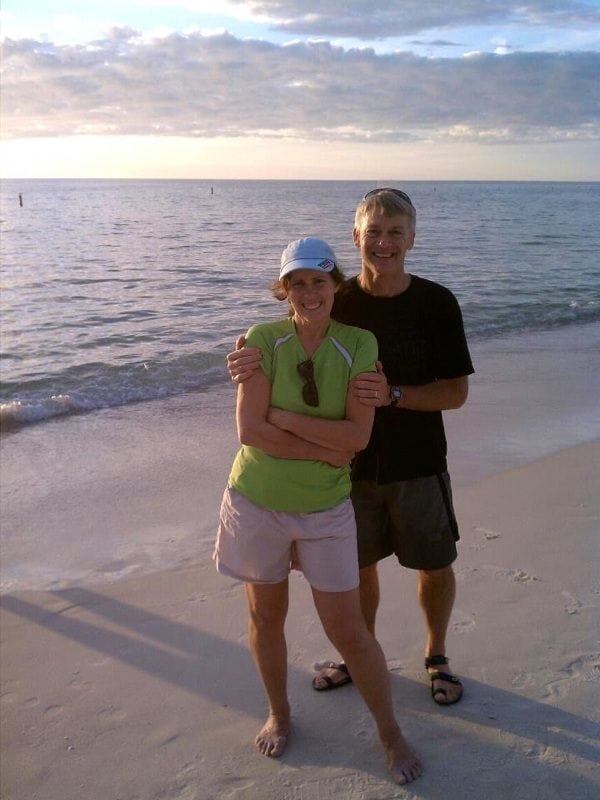
Tim and Loreen at the beach in 2011.
The first ultra he ran, the Laurel Highlands Ultra, back in the 1990s, was along a 70-mile trail called the Laurel Highlands Trail that cut diagonally across Pennsylvania. “It was very local and I thought I had nothing to lose,” he said. “After I ran it I was hooked.” Now he, Loreen, and another runner, Rick Freeman, have together been the race organizers for many years. The race is a Western States qualifier and is the second-longest running ultra in the U.S.
Tim prefers races that are pure ultrarunning battles. “I enjoy the course at Hardrock, but it is not really a runner’s race, in my opinion,” he stated as an example. “It is more of an adventure race.” The JFK 50 Mile, on the other hand, is favorite for Tim.
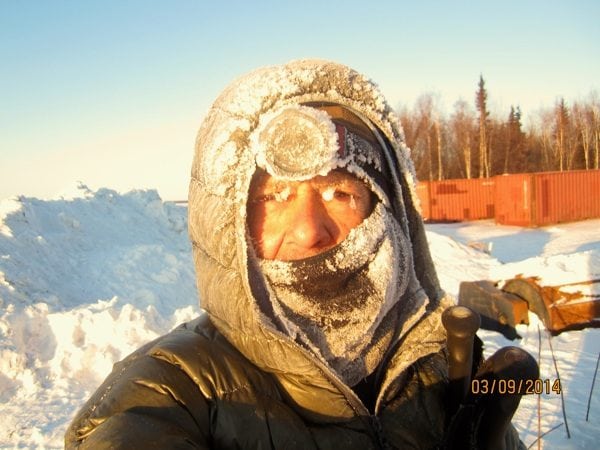
Tim snapping a selfie near the Yukon River.
Additionally, the longer the distance, Tim realized, the better he could perform. In Alaska he found the distance for him, but it took some time and some heat before he realized that.
He completed the Badwater Ultramarathon for the first time in 2000. Ten years later he ran the race again, plus the Furnace Creek 508 [-mile bicycle race], which is now called the Silver State 508. This makes Tim a “Death Valley Cup” finisher, one of those who have completed both desert-based races in one calendar year.
The invite for the bike race came days after Tim crashed his bike during a ride in the Laurel Highlands with his daughter. The chain went through his calf. He couldn’t flex his foot, couldn’t run at all. But he could still bike. “I did fine,” he said, as if he just took stroll down the sidewalk. “I finished about 22nd place so I did well. That race got me kind of addicted to riding bikes, too.”
And that is where the story picks up again. But first, some more history.
It was also in the year 2000 when Tim decided to do the Susitna 100 Mile in Alaska and where he beat the course record by almost four hours. The Iditarod race was still just an idea, but it was in Death Valley during Badwater when it became a reality.
“I was running up that stupid mountain in that 119-degree [Fahrenheit] heat and thinking What am I doing? This is absurd. I can go to Alaska and that would be way more fun than this.”
By then, Tim was in the peak of his running and the Alaskan race seemed doable, he said.
In 2001 he signed up and completed his first time in the 1,000-mile race. That’s where it all started, he said. The route for the foot race flip flops between the Northern and Southern Routes, and the mileage is never the same. It is jokingly called the 1,049-mile race since Alaska was the U.S.’s 49th state, Tim added.

Tim and Loreen on top of Rainy Pass.
During 12 attempts and nine finishes of the event, Tim has experienced it all. He certainly has 12 different stories:
2001: On the Southern Route, he finished in 26 days, 20 hours, and 46 days. There were only four finishers: two on bikes and two runners. Tim finished with a tibia stress fracture. “I was in a lot of pain, it was pretty horrible,” he said. “I said I would never do this again. My feet were horrible and a lot of the time I didn’t enjoy it. After the 2001 race I said I should probably do the Northern Route and then be done with this, but I wasn’t ready in 2002 to go back. I was still recovering and still wore out.” So in 2002 and 2003 Tim remained in Pennsylvania, since the 2003 race was another Southern Route, he had no interest in doing it again.
2004: Northern Route. 23 days, 22 hours, and 10 minutes. Tim was the only finisher in any discipline.
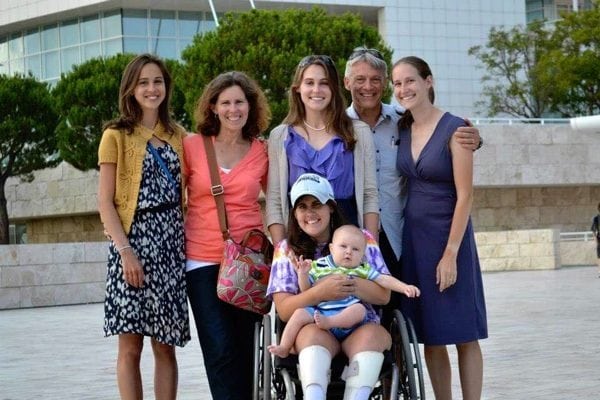
The Hewitt family, including Caitlin Hewitt, Abby Hewitt, Loreen Hewitt, Tim Hewitt, Amanda Moore, and Brittany Hewitt.
2008: Northern Route. 24 days, 6 hours, and 28 minutes. Tim was the only foot finisher with five finishers on bikes.
2009: Southern Route. 25 days, 9 hours, and 29 minutes. Only Tim and one other racer, Italian, Marco Berni, finished, both runners.
2010: Northern Route. 22 days, 4 hours, and 15 minutes. Three bikers and two runners finished.
2011: Southern Route. Tim set the current Southern Route course record at 20 days, 7 hours, and 17 minutes. Three bikers and two foot racers finished.
2012: Northern Route. The race directors stopped everyone at McGrath, 350 miles into the race, due to inclement weather, so no one finished.
2013: Southern Route. 24 days, 20 hours, and 31 minutes. Five foot finishers, including previous WeRunFar subject Shawn McTaggert who set the women’s record at 30 days, 18 hours, and 10 minutes, and three bikers completed the race. Tim started and raced the entire distance unsupported, meaning he carried everything he needed for the entire 1,000 miles. On the sled every runner drags behind, Tim carried 70 to 80 pounds of food, plus gallons of water, and the necessary items: a sleeping bag, clothes, and other survival gear. Typically, a runner will carry under 50 pounds of material and send packages of food to villages along the way.
“I don’t believe in taking tents and I have streamlined the weight of my food,” he said, something that only thousands of miles in the race can teach somebody. For Tim, his food included things from which you can get the most caloric bang for your buck: freeze-dried food, peanut butter, and jerky. “And a lot of chocolate and candy,” he added. “I eat a lot of candy. Mike and Ikes are a staple for me.”

Tim trekking along the Yukon River.
2014: Northern Route. 26 days, 6 hours, and 59 minutes. Tim finished the race side by side with Loreen as she set the current women’s course record for the Northern Route. He and Loreen finished with two men ahead of them and one woman, McTaggert, a few days behind. There were 11 bike finishers, making 2014 the year with the most finishers since 2001.
2015: Southern Route. Tim did not finish. Tim decided to attempt the race on a fat-tire bike rather than run. Loreen finished the 350-mile race in 7 days, 10 hours, and 45 minutes and with a case of frostbite that led to the partial amputation of her thumb. “She’s the second woman to ever make it to Nome on foot and still holds the record,” he said. “A couple of times we stayed together for the 350 mile, but the last few times we have said our goodbyes at the start line. She’s fine out there.” Last year, Loreen caught Tim while she was trekking on foot and he was manually pushing his 60-pound bike through deep snow. “It wasn’t going well,” he admitted, trying to heave the bike forward with his chest and arms. “I was going about one tenth of a mile an hour, according to the [GPS] tracker [that participants wear].”
2016: Northern Route. Tim set a new record for this route at 19 days, 9 hours, 38 minutes. There were four runners and 10 bike finishers.
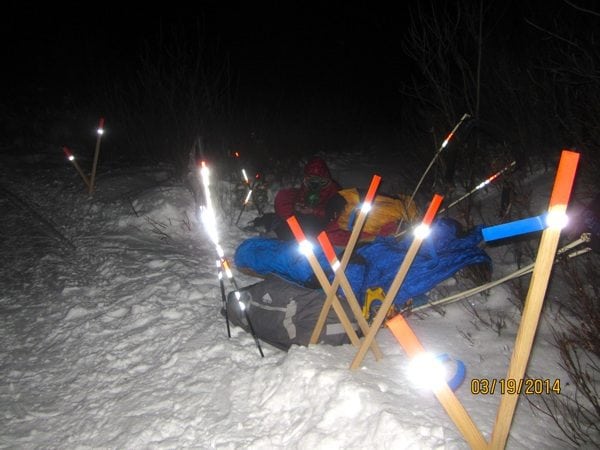
Tim’s campsite for a night during the race.
The 2016 race did not start well for Tim, who spent the first day throwing up and dry heaving everything in his stomach, thanks to some bug he believes he caught. With sickness delaying him, and then a 15-to 20-mile off-course detour about 250 miles in, Tim said he was doing the math in his head for a long time to see if he was still on track.
Then, when he arrived at a small village, he decided to rest at a school for the night. “I went inside and there was a lot of food there,” he said. “I ate like a pig. I had a lot of foot problems to deal with though. I ended up sleeping for six hours and when I got up I ate a lot of food again.” Tim said he felt pretty guilty after the little “vacation,” but after the rest and food, he realized he felt good and he was ready to get back on pace.
Over the years of Iditarod races, Tim has almost everything figured out, from food, to sleeping, to making cold-weather adjustments. While running at night, Tim says he tries to stay awake and keep moving till about 2 a.m., then he stops to sleep and rise again around 6 a.m. This way, he is still sleeping when it is dark, rising with the sun, and able to keep moving during the night when the temperature is at its coldest. Tim assured me the body can handle 20, 30, even 40 degrees below zero Fahrenheit, if there is no wind.
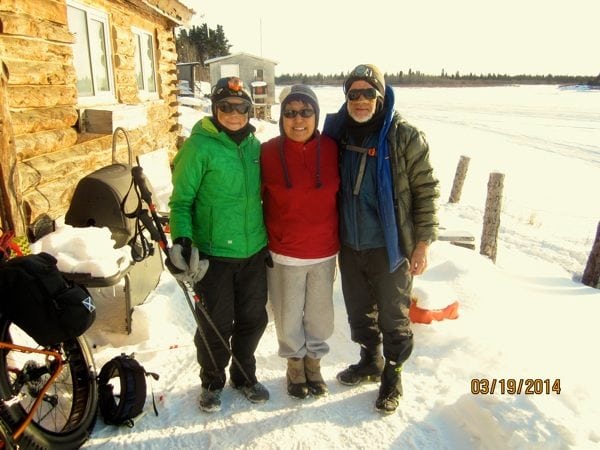
Tim and Loreen with Joanna Wassillie at her home on White Mountain. She supplies food and a place to sleep for the racers.
“Wind creates the problem. When it gets to 30 or 40 below with wind, you cannot stop. Period,” he said. “You can’t have any skin showing. It will freeze within a minute.” The ideal temp for Tim is between 10 degrees below and above zero Fahrenheit.
The dryness gets difficult, too, he added. “When it gets that dry, the moisture gets pulled right out of you,” he said. “But when it gets really bad and you’re losing your core body temperature, really the only thing to do is jog. You’re pulling a sled, you will warm-up.”
Managing the cold and sleeping on the trail are the two biggest advantages Tim has learned that have helped him battle through each race. “It really doesn’t matter much to me whether I sleep in a building or out in the snow and I think this has helped me because I sleep when I can’t stay awake anymore,” he said. Tim often continues until he can’t keep his eyes open, and then takes a short, 45-minute nap.
“He doesn’t wait for the villages,” Kathi Merchant said. She and her husband, Bill, are the Iditarod Trail Invitational race directors. “He just goes until he falls asleep on his feet, then gets up and goes non-stop. That’s his style of continuous movement, naps on the trail.”
This past March, Tim was running on four hours of sleep and within the last five days of the race, he only accumulated six hours of sleep total. However, despite the lack of sleep, Tim bounded into Nome with plenty of time.
“I knew I had [the record] at White Mountain,” he said, which is about 77 miles from the finish. With time to spare, Tim said he decided to enjoy himself. Within the last 22 miles of the race there is a little mountain, about an 800-foot climb, which everyone usually goes around since it is nearly the same distance around as up and over it, he said. “I was feeling good so I decided to just go over it,” he said. “I just didn’t want to take any shortcuts. I wanted to get that full experience.”
Another reason to voluntarily hike up a climb so late in a long race? The probability of not doing it again.
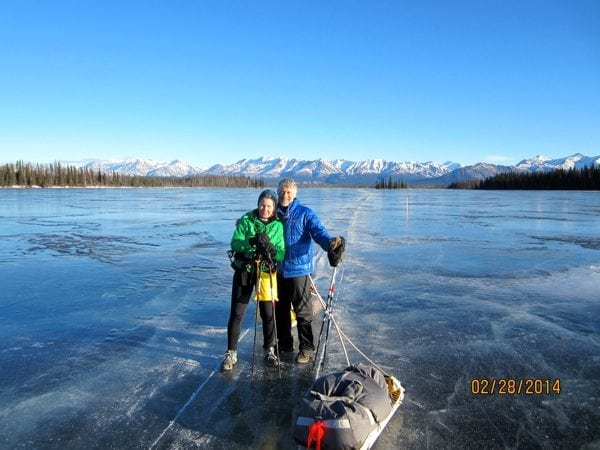
Tim and Loreen on Farewell Lake.
Tim cannot stay away from the Alaskan race, but his list of ways to run and beat this race is coming to an end.
- Northern Route record: 19 days and change
- Southern Route record: 20 days and change
- Unsupported: 24 some-odd days
- Loreen: 26 some-odd days
So what exactly is next? Back to the fat-tire bike, he said.
“I don’t think I will go back on foot. I don’t know what else there is to do on foot,” he said. “I love being up there so the next thing there is the bike. I am excited to do it on the bike, but we will see what happens.”
What happens between each year’s Alaskan race is pretty much the same. Recovery, where Tim is now, is just a given: “I’m going to be sore.”
“I have learned from experience. Yeah, I will get sore, my knees will hurt, my hips will hurt, and I will be thankful for the first pain-free steps,” he said. “But I have learned I get stronger during the race. I am always faster in the last part of the race.”
As the pain begins to decrease in the weeks after returning home, Tim acknowledges his less groggy, less sleep-deprived mind and the disappearing soreness of his muscles. Tim also realizes that there is still a lot left to heal. “There’s probably some nerve damage in my feet that will begin to come back eventually, and I have lost every toenail,” he said. Still, the toll on his body is not enough to break his spirit.
“You dive deep in the tank for this race and it takes a long time to recover,” he said. “I would blame it on my age if it wasn’t for the fact I feel like this after every race, even in 2001 when I was at the peak of my running ability. It is just a draining event.” Draining, both physically and mentally. The race tests strength, coordination, direction, and the body and soul of each runner.
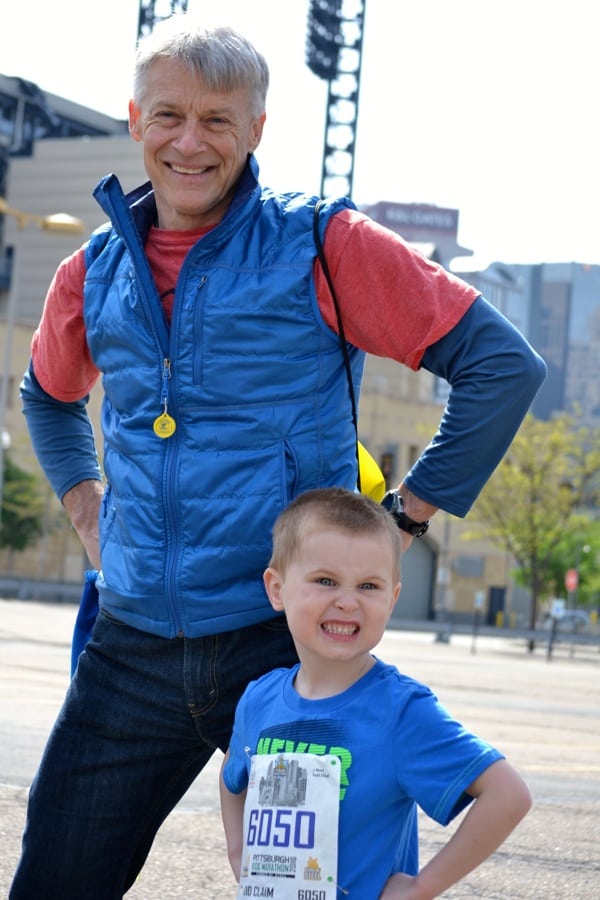
Tim with his grandson, Joshua, who just ran his first race, the one-mile distance, during the Pittsburgh Kids Marathon in May 2016.
The feet are put through 1,000 miles of snow and cold sweat, eventually leading to blisters. The body is blown headfirst by wind, snow, and ice. Many racers, Tim says, reach McGrath, 350 miles into the event, and cannot force themselves to keep going. Even with hours spent in the months before the race readying themselves with research from documentaries, articles, and reading the Iditarod bible written by Tim himself and co-author, Jill Homer, an Iditarod Trail Invitational 1,000-mile bike finisher, 8,000 Miles Across Alaska: A Runner’s Journeys on the Iditarod Trail.
“The race directors call it gut-check time,” Tim said. “I call it the point of no return.”
“I go out there and do it. I have no concern I am going to die.” Tim is a legend, or a superhuman, according to Kathi and Bill Merchant.
I agree, though I remember one thing he said that made me smile during our phone conversation, which shows me that wrapped around Tim’s muscles and bones isn’t a special form of Iditarod insulation as I imagine there could be, but skin that is just the same as all of us. “I am so not a cold-weather person,” he said, sitting at his desk, while the Pennsylvanian spring weather blew snow flurries past his window. “My wife laughs at me in the winter here.”
The last few minutes of the interview, Tim asked me about my own running, but I knew what the final question would be and I knew I had to tell the truth. “So, have I convinced you yet?” he asked.
The Iditarod Trail Invitational. The “impossible.” Sorry, Tim. No thank you, but good luck next year.
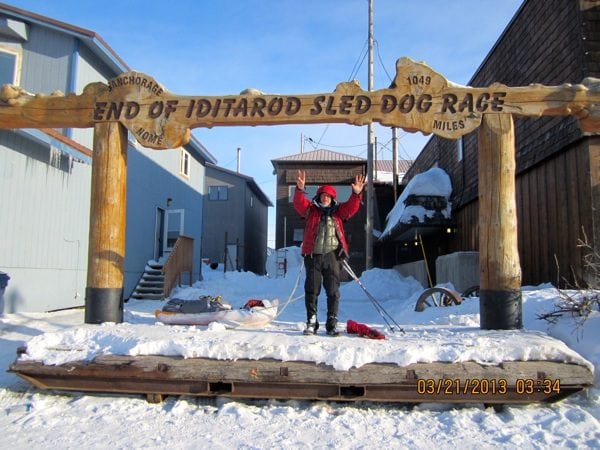
Tim finishing at Nome during the 2013 Iditarod Trail Invitational.
Call for Comments (from Meghan)
Calling all Tim Hewitt stories! Time to share your best anecdote about this Iditarod Trail Invitational legend in the comments section.
